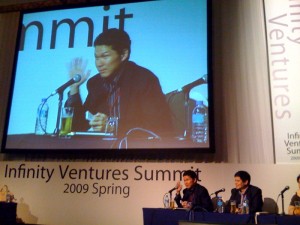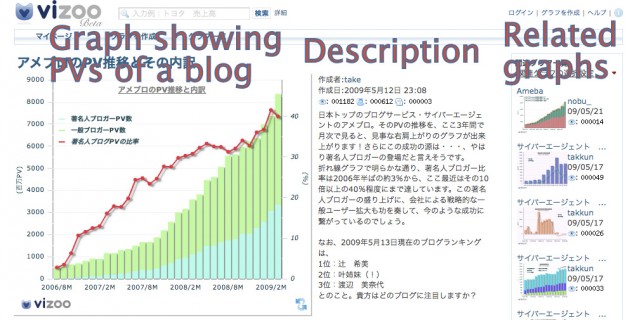 I am currently in Sapporo/Japan, attending the Infinity Ventures Summit (IVS) [this and many of the following links are in Japanese], a two-day event that takes place twice a year. Organizing VC company Infinity Venture Partners regularly not only attracts the cream of the crop of the domestic web industry but also a number of high-profile attendees from abroad. This time, these include RockYou CTO and founder Jia Shen (whose company is currently expanding to Japan), Admob CEO Omar Hamoui, (who today announced Admob’s foray into the Japanese market), Korean web entrepreneur Chang Kim (who recently sold his Seoul-based company to Google and writes a highly recommended English blog about Korea’s web scene) and Casee CEO Xin Ye (Casee is China’s answer to Admob).
I am currently in Sapporo/Japan, attending the Infinity Ventures Summit (IVS) [this and many of the following links are in Japanese], a two-day event that takes place twice a year. Organizing VC company Infinity Venture Partners regularly not only attracts the cream of the crop of the domestic web industry but also a number of high-profile attendees from abroad. This time, these include RockYou CTO and founder Jia Shen (whose company is currently expanding to Japan), Admob CEO Omar Hamoui, (who today announced Admob’s foray into the Japanese market), Korean web entrepreneur Chang Kim (who recently sold his Seoul-based company to Google and writes a highly recommended English blog about Korea’s web scene) and Casee CEO Xin Ye (Casee is China’s answer to Admob).
The program also includes a launch pad, which just took place and gave a total of 12 Japanese start-ups the chance to present their wares onstage to a panel of judges and a crowd of about 300 people. But the word “Launch Pad” is a slight misnomer as IVS serves as a venue also for established start-ups to get their products in front of as many influential bloggers, VCs and entrepreneurs as possible. So unlike TechCrunch50, for example, the IVS concept doesn’t require companies to actually start businesses here.
In the end, a service called MotionPortrait won the title of best startup of the IVS Launch Pad.
You can read my thumbnail sketch of each of the five award-winning contenders below, along with my personal impressions. Please note some of the companies have yet to launch homepages in English.
 Best of show went to Sony-backed MotionPortrait, whose technology makes it possible to generate a 3D face model based on a single 2D picture. The model can then be spiced up with various animations and graphical effects. You can make people dance, frown, laugh or even replace an actor’s face in a movie with your own.
Best of show went to Sony-backed MotionPortrait, whose technology makes it possible to generate a 3D face model based on a single 2D picture. The model can then be spiced up with various animations and graphical effects. You can make people dance, frown, laugh or even replace an actor’s face in a movie with your own.
MotionPortrait isn’t limited to human faces, as you can manipulate pictures of animals and objects in the same way (think dancing Easter Island statues or laughing leopards).
This may sound slightly goofy, but the technology is really impressive. MotionPortrait operates in a crowded market, but the technology is in my view more powerful than the one Israel-based Gizmoz offers, for example. Very cool stuff that can be used in games, virtual worlds, advertising campaigns or social networks.
Watch the video below for a demo.
![]()
Deqwas A recommendation engine called Deqwas came in second. Developed by Tokyo-based Scigineer, the engine is currently being used by over 30 e-commerce sites, blogs and social networking sites in the fixed and mobile web. The company also managed to license out its technology to US-based services, i.e. to this online bridal store. Deqwas is financially backed by cross-country (US and Japan) incubator Innovation Kitchen, a Mitsubishi subsidiary.
![]()
Vizoo I really liked the concept behind second-ranked Vizoo (there wasn’t a third prize this time), a YouTube for graphs. Developed by Tokyo- and Chicago-based Fillmore Advisory, the service will be available in English “in the near future”, as Vizoo representative Kosuke Mori told me.

Asked what the main difference between his service and American counterparts icharts or Swivel is, Mori said Vizoo offers users rich data bases they can immediately start working with. Graphs can be created using Vizoo or won data, tagged and commented on. The graphs can later be shared not only on Vizoo itself but also integrated into other sites and widgetized. Very useful for business analysts, journalists, scientists etc., but I see difficulties in monetizing the site. Still Mori is optimistic, saying by launching Vizoo, he wants to “destroy” established players like Bloomberg or Reuters.
![]()
Cerevo A new photo management service called Cerevo came in fourth at the show. The company intends to provide a double-sided solution for people wanting to send and share pictures online by not only developing a new photo management site but also manufacturing a digital camera completely from scratch.

The camera will automatically send pictures users took to Cerevo’s “online photo album” via Wifi. At the same time, users are notified through a message going to their inbox. You can then send pictures stored on Cerevo servers to friends or to various social networks using email. The big idea here is that the camera is only needed to take the pictures. Users don’t need direct access to the device or files in order to share pictures with others. Cerevo claims the concept is unique on a worldwide level.
CEO Takuma Iwasa said his company (that he established after leaving Panasonic – a rare move in big company-crazy Japan) plans to sell the camera worldwide starting this summer (the project is currently in prototype status). We will stay tuned.
![]() Ameba Pigg The award for fifth place went to Ameba Pigg, a virtual world developed by Tokyo-based Internet giant Cyberagent. Ameba Pigg saw 350,000 registrations since its launch three months ago, with development taking just four months.
Ameba Pigg The award for fifth place went to Ameba Pigg, a virtual world developed by Tokyo-based Internet giant Cyberagent. Ameba Pigg saw 350,000 registrations since its launch three months ago, with development taking just four months.
Ameba Pigg, which is available in Japanese only, is your typical teenager-focused virtual world with cute avatars, flashy settings and annoying sound effects. There are dozens of virtual worlds like this out there. Nothing special. Watch the video to get an impression of Ameba Pigg’s look and feel.
The seven other Japanese startups that presented at the launch pad are covered here.